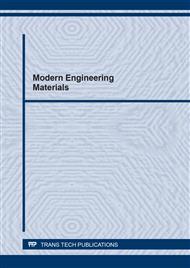[1]
B. Waisi, Produced water treatment for beneficial use: emulsified oil removal, (2016). https://doi.org/10.3990/1.9789036541572.
Google Scholar
[2]
C.J. Umembamalu, C. Adaobi Igwegbe, E.U. Osuagwu, J.T. Nwabanne, Packed bed column adsorption of oil and grease from refinery desalter effluent, using rice husks derived carbon as the adsorbent: Influence of process parameters and Bohart-Adams kinetics study, (n.d.).
DOI: 10.29333/ejosdr/9285
Google Scholar
[3]
A. Fakhru'l-Razi, A. Pendashteh, L.C. Abdullah, D.R.A. Biak, S.S. Madaeni, Z.Z. Abidin, Review of technologies for oil and gas produced water treatment., J. Hazard. Mater. 170 (2009) 530–551. https://doi.org/10.1016/J.JHAZMAT.2009.05.044.
DOI: 10.1016/j.jhazmat.2009.05.044
Google Scholar
[4]
N.W. Ingole, S.S. Vinchurkar, S. V Dharpal, Adsorption of oil from waste water by using human hair, J. Environ. Sci. Comput. Sci. Eng. Technol. 3 (2014) 207–217.
Google Scholar
[5]
M. Al-Kaabi, A.B. Ghazi, R. Qunnaby, F. Dawwas, H. Al-Hadrami, Z. khatir, M. Yousif, T. Ahmed, M.A. Al-Ghouti, Enhancing the Quality of Produced Water, by Activated Carbon, 2016 (2016) EEPP2459. https://doi.org/10.5339/QFARC.2016.EEPP2459.
DOI: 10.5339/qfarc.2016.eepp2459
Google Scholar
[6]
S.M. Alardhi, F.Y. AlJaberi, L.M. AlSaedi, Studying the treatability of different types of nanoparticles for oil content removal from oily wastewater produced from refinery process, Egypt. J. Chem. 63 (2020) 4963–4973. https://doi.org/10.21608/EJCHEM.2020.11981.1752.
DOI: 10.21608/ejchem.2020.11981.1752
Google Scholar
[7]
A. Srinivasan, T. Viraraghavan, Oil removal from water using biomaterials, Bioresour. Technol. 101 (2010) 6594–6600. https://doi.org/10.1016/J.Biortech.2010.03.079.
DOI: 10.1016/j.biortech.2010.03.079
Google Scholar
[8]
S. De Gisi, G. Lofrano, M. Grassi, M. Notarnicola, Characteristics and adsorption capacities of low-cost sorbents for wastewater treatment: A review, Sustain. Mater. Technol. 9 (2016) 10–40. https://doi.org/10.1016/J.SUSMAT.2016.06.002.
DOI: 10.1016/j.susmat.2016.06.002
Google Scholar
[9]
A.D. Alsulaili, A.M. Fahim, Oil removal from produced water by agriculture waste adsorbents, (2020).
DOI: 10.1504/ijewm.2020.10026030
Google Scholar
[10]
M. Al.Haddabi, H. Vuthaluru, H. Znad, M. Ahmed, Removal of Dissolved Organic Carbon from Oily Produced Water by Adsorption onto Date Seeds: Equilibrium, Kinetic, and Thermodynamic Studies, Water, Air, Soil Pollut. 2015 2266. 226 (2015) 1–15. https://doi.org/10.1007/S11270-015-2443-1.
DOI: 10.1007/s11270-015-2443-1
Google Scholar
[11]
K. Ukanwa, K. Patchigolla, R. Sakrabani, E. Anthony, S. Mandavgane, A Review of Chemicals to Produce Activated Carbon from Agricultural Waste Biomass, Sustainability. 11 (2019) 6204. https://doi.org/10.3390/su11226204.
DOI: 10.3390/su11226204
Google Scholar
[12]
M.H.A. Megid, A.A.R. Amer, K.H. Elsayed, Coagulation and dissolved air floatation for treatment of oil-water emulsion, Int. J. Eng. Sci. 3 (2014) 120–129.
Google Scholar
[13]
E. Eren, O. Cubuk, H. Ciftci, B. Eren, B. Caglar, Adsorption of basic dye from aqueous solutions by modified sepiolite: Equilibrium, kinetics and thermodynamics study, DES. 252 (2009) 88–96. https://doi.org/10.1016/j.desal.2009.10.020.
DOI: 10.1016/j.desal.2009.10.020
Google Scholar
[14]
M.S. Mahmoud, O. Fadali, E. Ebrahiem, T. Farrag, M. Mahmoud, Treatment of oily wastewater produced from refinery processes using adsorption technique Development of standalone solar water desalination system based on humidification-dehumidification technology View project Conference View project treatment of oily wastewater produced from refinery processes using adsorption technique, Minia J. Eng. Technol. 32 (2013).
DOI: 10.1016/s1383-5866(03)00067-4
Google Scholar
[15]
I. Langmuir, The constitution and fundamental properties of solids and liquids. Part I. Solids, J. Am. Chem. Soc. 38 (1916) 2221–2295. https://doi.org/10.1021/JA02268A002.
DOI: 10.1021/ja02268a002
Google Scholar
[16]
E.A. Emam, Modified activated carbon and bentonite used to adsorb petroleum hydrocarbons emulsified in aqueous solution, Am. J. Environ. Prot. 2 (2013) 161–169. https://doi.org/10.11648/j.ajep.20130206.17.
DOI: 10.11648/j.ajep.20130206.17
Google Scholar
[17]
R.E. Treybal, Mass transfer operations, New York. 466 (1980).
Google Scholar
[18]
N.M. Mubarak, N. Sazila, S. Nizamuddin, E.C. Abdullah, J.N. Sahu, Adsorptive Removal of Phenol from Aqueous Solution by Using Carbon Nanotubes and Magnetic BioChar, NanoWorld J. 03 (2017) 32–37. https://doi.org/10.17756/NWJ.2017-043.
DOI: 10.17756/nwj.2017-043
Google Scholar
[19]
Y.S. Ho, G. Mckay, Kinetic models for the sorption of dye from aqueous solution by wood, (n.d.). https://doi.org/10.1205/095758298529326.
Google Scholar
[20]
C. Lu, F. Su, Adsorption of natural organic matter by carbon nanotubes, Sep. Purif. Technol. 58 (2007) 113–121. https://doi.org/10.1016/j.seppur.2007.07.036.
Google Scholar
[21]
M. Al Haddabi, H. Vuthaluru, H. Znad, M. Ahmed, Removal of dissolved organic carbon from oily produced water by adsorption onto date seeds: Equilibrium, kinetic, and thermodynamic studies, Water. Air. Soil Pollut. 226 (2015). https://doi.org/10.1007/s11270-015-2443-1.
DOI: 10.1007/s11270-015-2443-1
Google Scholar
[22]
S. Kaur, A.K. Sodhi, A study on removal of cutting oil from wastewater by using agricultural wastes, in: Mater. Today Proc., Elsevier Ltd, 2020: p.719–727. https://doi.org/10.1016/j.matpr.2020.03.328.
DOI: 10.1016/j.matpr.2020.03.328
Google Scholar


